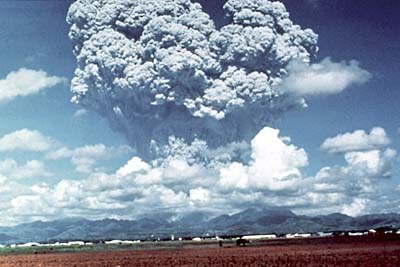There has been a lot in the news recently about current volcanic activity – Merapi in Indonesia and Bezymianny in the Kamchatka peninsula in Russia, but while most reports have focussed on the very real dangers to the local populace and air traffic, volcanoes can have important impacts on climate as well. However, there are a number of conditions that need to be fulfilled before an eruption will show up in the climate record.

There can be some exceptions to the tropics-only rule, and at least one high latitude volcano appears to have had significant climate effects; Laki (Iceland, 1783-1784). The crucial factor was that the eruption was almost continuous for over 8 months which lead to significantly elevated sulphate concentrations for that whole time over much of the Atlantic and European regions, even though stratospheric concentrations were likely not particularly exceptional.
One point that is also worth making is that although volcanoes release some CO2 into the atmosphere, this is completely negligable compared to anthropogenic emissions (about 0.15 Gt/year of carbon, compared to about 7 Gt/year of human related sources) . However, over very long times scales (millions of years), variations in vulcanism are important for the eventual balance of the carbon cycle, and may have helped kick the planet out of a ‘Snowball Earth’ state in the Neo-proterozoic 750 million years ago.
Volcanoes can provide great tests for climate models, and indeed, predictions of the impacts of Pinatubo (before they happened) proved very accurate (about a 0.5 C cooling after about 18 months) – for instance in Hansen et al (1992). Other studies have examined the dynamic impacts of volcanic eruptions (the ‘winter warming’ – Robock and Mao, 1992; Shindell et al 2004), the water vapour feedback as the planet cools (Soden et al, 2001), the impact of high-latitude eruptions (Oman et al, 2005), impacts on ENSO (Mann et al, 2005) and have shown that the models work pretty well.
So what of the current eruptions? Well Bezymianny appears to be explosive enough, but its latitude (55 N) will tend to preclude it having any big climate impact. Merapi is in the right location but doesn’t appear (so far) to be explosive enough to put anything in the stratosphere, and so this too seems unlikely to impact climate. At some point, there will be another climatically important eruption, but it hasn’t happened yet…
Re: #50
Indeed, fig. 4 in Hansen et al. is solar forcing, not temperature. Also, the figure indicates solar irradiation in Watts per square meter. That’s the increase in solar energy intercepted by a square meter which is exposed to sunlight head-on. But earth’s surface area (4 pi r^2) is four times earth’s cross-sectional area (pi r^2), so any indicated change in solar irradiance should be divided by 4 to compute the change in solar forcing on earth.
I’ve specifically looked for any hint of the 11-year solar cycle in the global temperature record, and found none. I’m not aware of any scientific work which claims there is a hint of it.
Take a good look at Hansen et al.’s figure 5(a), to get an idea of the strength of solar forcing compared to that of greenhouse gases.
Jack, look at the left side of that Fig. 4 — the scale is numbered and units shown.
The bottom of the chart is not zero — the lowest number shown is 1364 watts per square meter.
The highest number shown is 1367 watts per square meter. The curve doesn’t reach either of those.
The difference between higher and lower parts of that curve is, eyeballing it, roughly 2 w/m-squared.
That’s how much the sun is changing over that span of years. (That’s not how much reaches the ground or we’d all be toast!)
The variation is small, very small. It’s real (Fig. 4 shows two estimates of what the sun actually did) — that difference does show up in Figure 6, as a very slight contribution to temperature change.
Can some one put things in perspective for me? How does our fossil fuel usage today compare to the Krakatoa erruption of 1883? Here is an excert of what that one event did to affect global temperature from wikipedia quote:
==============================================================
The eruption produced erratic weather and spectacular sunsets throughout the world for many months afterwards, as a result of sunlight reflected from suspended dust particles ejected by the volcano high into Earth’s atmosphere. The area around Java is now known as Lady Bull because of its fiery nature. This worldwide volcanic dust veil acted as a solar radiation filter, reducing the amount of sunlight reaching the surface of the earth. In the year following the eruption, global temperatures were lowered by as much as 1.2 degrees Celsius on average. Weather patterns continued to be chaotic for years, and temperatures did not return to normal until 1888. British artist William Ashcroft made thousands of color sketches of the red sunsets half-way around the world from Krakatoa in the years after the eruption. In 2004, researchers proposed the idea that the blood-red sky shown in Edvard Munch’s famous 1893 painting The Scream is also an accurate depiction of the sky over Norway after the eruption.
====================================
end quote.
Jack, Google “+krakatoa +warming”
http://www.llnl.gov/PAO/news/news_releases/2006/NR-06-02-02.html
See Hansen’s 1999 Congressional testimony — Scenario B.